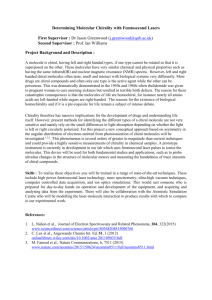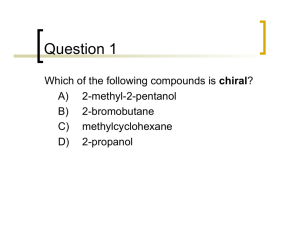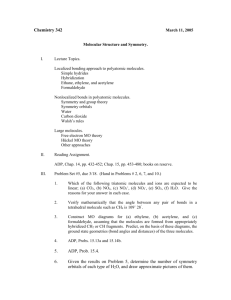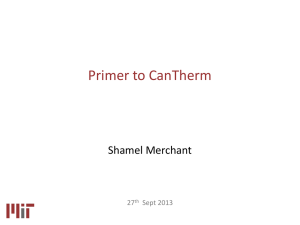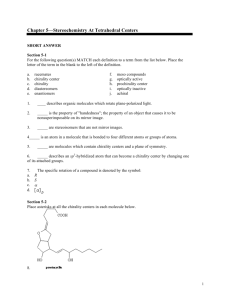lab 10: optical resolution
advertisement
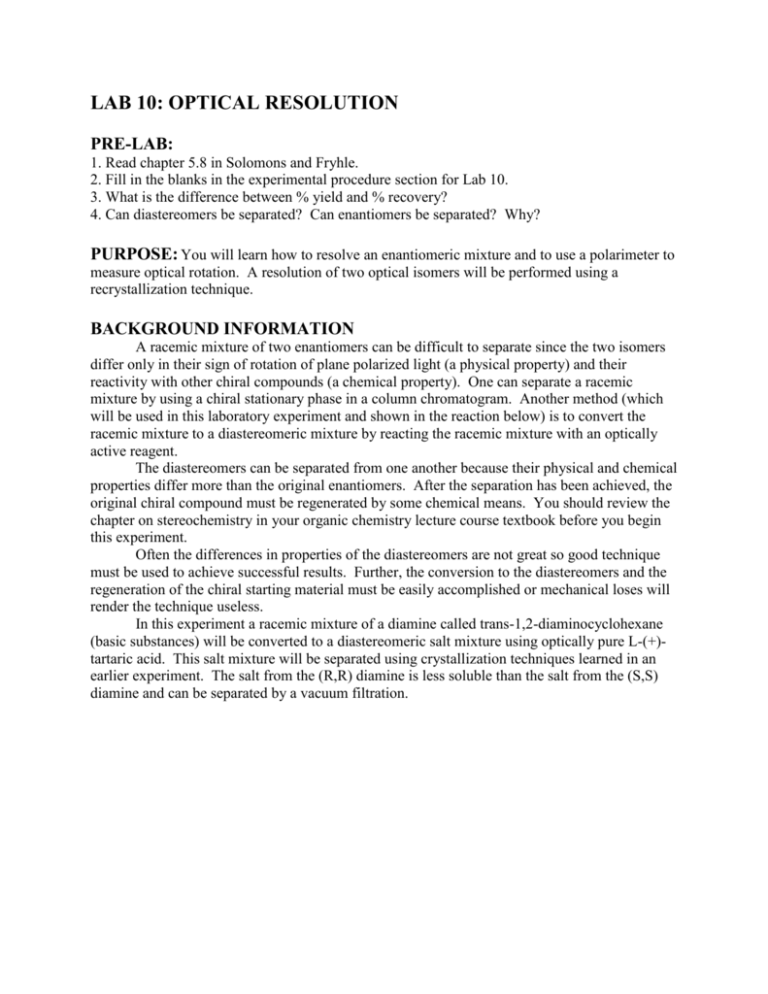
LAB 10: OPTICAL RESOLUTION PRE-LAB: 1. Read chapter 5.8 in Solomons and Fryhle. 2. Fill in the blanks in the experimental procedure section for Lab 10. 3. What is the difference between % yield and % recovery? 4. Can diastereomers be separated? Can enantiomers be separated? Why? PURPOSE: You will learn how to resolve an enantiomeric mixture and to use a polarimeter to measure optical rotation. A resolution of two optical isomers will be performed using a recrystallization technique. BACKGROUND INFORMATION A racemic mixture of two enantiomers can be difficult to separate since the two isomers differ only in their sign of rotation of plane polarized light (a physical property) and their reactivity with other chiral compounds (a chemical property). One can separate a racemic mixture by using a chiral stationary phase in a column chromatogram. Another method (which will be used in this laboratory experiment and shown in the reaction below) is to convert the racemic mixture to a diastereomeric mixture by reacting the racemic mixture with an optically active reagent. The diastereomers can be separated from one another because their physical and chemical properties differ more than the original enantiomers. After the separation has been achieved, the original chiral compound must be regenerated by some chemical means. You should review the chapter on stereochemistry in your organic chemistry lecture course textbook before you begin this experiment. Often the differences in properties of the diastereomers are not great so good technique must be used to achieve successful results. Further, the conversion to the diastereomers and the regeneration of the chiral starting material must be easily accomplished or mechanical loses will render the technique useless. In this experiment a racemic mixture of a diamine called trans-1,2-diaminocyclohexane (basic substances) will be converted to a diastereomeric salt mixture using optically pure L-(+)tartaric acid. This salt mixture will be separated using crystallization techniques learned in an earlier experiment. The salt from the (R,R) diamine is less soluble than the salt from the (S,S) diamine and can be separated by a vacuum filtration. NH2 H2N NH2 H2N HO + OH + HOOC racemic mixture of trans-1,2-diaminocyclohexane HO OOC L-(+)-tartaric acid OH HO COO H3N COOH OOC H3N NH3 OH COO NH3 + S,S-1,2-Diammoniiumcyclohexane mono-(+)-tartate (soluble in water) R,R-1,2-Diammoniiumcyclohexane mono-(+)-tartate (insoluble in water) The degree of success of your separation will be shown by the angle of rotation (alpha) you will measure for this salt in a polarimeter and comparing it to the specific rotation ([alpha]) by using the formula obs 1 dm x C g / mL = specific rotation obs = observed rotation 1 dm is the length of the polarimeter tube in decimeters C is the concentration in g/mL EXPERIMENTAL PROCEDURE: 1) Working in a fume hood, dissolve 5.0 mmol (___________ mL) of L-(+)-tartaric acid in 2.5 ml of distilled water. Stir the solution and add 10.0 mmol (___________ g) of trans-1,2diaminocyclohexane. Warm the solution for a brief period. Allow the solution to cool. Question: What sort of reaction is taking place between tartaric acid and -methylbenzylamine? 2) Add 0.5 ml of glacial acetic acid and cool the reaction mixture in an ice bath for 45 minutes. ***While your sample is cooling start the supplemental worksheet*** 3) Collect the precipitate that forms by vacuum filtration and rinse it with 0.5 ml of ice cold water followed by four 0.5 ml portions of room temperature methanol. Question: What are your crystals? What remains in the filtrate? 4) Dry your product, record its mass and calculate the percent yield. (See Techniques 1-5) Question: Do the crystals made by the other groups all have the same appearance? Describe how the crystals look. 5) You will not regenerate the liquid diamine in this experiment. You will use the optically pure salt for the polarimeter reading. To check the success of your separation, measure the optical resolution of the solid salt you obtained. Use a 10.00 ml volumetric flask for an accurate volume measurement. To do this add 0.200 g of the salt to the flask and then add the water until the meniscus is at the 10.0ml line. The salt is not very soluble in water, so do not use more than 0.200 g of the salt. If the salt does not dissolve at room temperature the instructor may use a heat gun to heat the sample. Calculate the concentration of the solution. ***While you are waiting for the polarimeter continue the supplemental worksheet*** 6) Place this solution in a 1 decimeter polarimeter tube. Record the angle of rotation that is observed. Be sure all weight and volume readings are accurately measured and recorded. From your data, compute the specific rotation and compare your value to the literature value which is 12.4 degrees. IMPORTANT INFORMATION ABOUT THE REPORT: A full report is required. Be sure you accurately record all important measurements that you make in this experiment. You will need to compute your percent yield of the optically pure salt you obtained and its specific rotation which you will compare to the literature value. Show your calculations Include a short paragraph in the discussion about how you could convert your salt back to the free diamine. Describe the experimental details that would be needed to regenerate your optically pure diamine. END OF EXPERIMENT. © 2011 Carberry and Carreon Stereochemistry Supplemental Worksheet Name___________________________ Stereochemistry requires the understanding of a certain vocabulary. The following terms are defined or cited in standard organic chemistry textbooks. Use these terms to complete the exercise and to prepare your report. absolute configuration: The actual 3-D arrangement of a molecule or a stereogenic center. This is often determined by X-ray analysis and is properly labeled with R and S notation. asymmetric: Without symmetry or devoid of any symmetry. axis of symmetry: An axis such that rotation by less that 360° produces a new representation indistinguishable from the original. For example, if rotation by 180° positions all atoms identically to the original the axis said to be two-fold and denoted as C2; likewise if a rotation of 120° produces the original positioning, the axis is three-fold. center of symmetry: a point in the center of the molecule is a center of symmetry if any line draw from it to some element of the structure will, when extended an equal distance in the opposite direction, encounter an identical element. chirality: The property of handedness. Your hands are chiral. conformer: Conformers are various forms of a single molecule that can be interconverted without breaking bonds. Conformers can be interconverted by rotation about single bonds, as well as by bending or folding molecules. diastereomer: Molecules that are stereoisomers but not mirror images. The 2S,3R and 2R, 3R molecules in 2-bromo-3-chlorobutane are diastereomers. dissymmetric: Devoid of reflection symmetry. Molecules must be dissymmetric to be optically active. enantiomers: Stereoisomers that are mirror images but not superimposable. isomers: Molecules that have the same molecular formula but different structures. meso form: A molecule that contains one or more molecular planes of symmetry, in spite of having two or more stereogenic centers. meso plane: A molecular plane of symmetry; molecules with two halves that are related by reflection are said to have a meso plane. This term is properly applied only to planes for molecules that also have sites of atomic chirality. optical activity: The ability of molecules to rotate plane polarized light. Only molecules that are dissymmetric can display optical activity. Molecular chirality is a necessary condition for optical activity. Atomic chirality (four different groups attached to a carbon atom) is useful in looking for molecular chirality, although molecules (for example, helixes) can be chiral without atomic chirality and molecules can have atomic chirality but not molecular chirality (for example, meso forms). plane of symmetry: A plane of symmetry bisects a molecule so that one half of the molecule is the mirror image of the other half. R/S notation: The assignment of absolute configuration to chiral carbon centers using priority rules. This is also called the Cahn-Ingold-Prelog notation. stereoisomer: These are isomers that have the same sequence of bonds and atoms but differ only in the spatial arrangement of the atoms. Within this general category are geometric (cis/trans) isomers, enantiomers, and diastereomers. symmetry operation: An operation carried out on an object (or molecule) that produces an orientation indistinguishable from the original. This includes axes of symmetry, planes of symmetry and centers of symmetry. Answer the questions in the space provided. The Chiral Carbon Atom 1. Construct a model that has a central carbon atom with four different colored spheres attached to it, representing four different atoms or groups. Fill in the line-and-wedge drawing below to represent this model and answer the following question: (a) Does the model have a plane of symmetry? The central carbon atom is said to be a chirality center. Most molecules of nature are chiral. The word “chiral” is derived from the Greek word, cheir and means “handed.” Chiral molecules are related to their mirror images in the same way that your left hand is related to your right hand. They are not identical! Change one of the colored spheres so that two of the four spheres are the same (b) fill in the 3-D structure below and answer the following questions: c) Does the molecule now possess a plane of symmetry? d) In view of your answers to a–b above, what condition is necessary for a molecule to be chiral? 2. (a) Label all chirality centers with an asterisk in the following top-selling antihistamines. Tell how many stereoisomers are possible for each. Cl O N N OH O N Cl NMe2 O N O O Loratadine (Clartin®) Cetirizine (Zyrtec®) Diphenhydramine (Benadryl®) (b) Following are structural formulas for three of the most widely prescribed drugs to treat depression. Label all chirality centers with an asterisk in each compound. Cl CF3 F Cl O N N H O H N N Escitalopram (Lexapro®) Sertraline (Zoloft®) Fluoxetine (Prozac®) (c) Atorvastatin [Lipitor®, Pfizer] is a member of the drug class known as statins, used for lowering blood cholesterol. With 2009 sales of US $12.5 billion, Lipitor® was the top-selling branded pharmaceutical in the world. Label all chirality centers in the compound with an asterisk. O N H OH N OH O OH F 3. Reconstruct the original carbon with four different colored spheres. Set the model on the table. Construct another model that is the mirror image of the first and place it on the table. a) Try to superimpose the two models. Are they the same or different? If different, in what sense? b) What is the stereochemical term that relates these two models? c) What two important properties must the two molecules (models) each have to be related by the term that is the answer to 3b? Choose one colored sphere on a model and remove it - Change it to match another color on that model. Do the exact same thing on the other model. d) Are the models still mirror images? e) Do the models have a plane of symmetry? If there is a plane of symmetry, describe its location. f) Are the models superimposable? g) Do the models represent identical or different molecules? Are they chiral? Explain. Diastereomers and Meso Forms 4. When a molecule has two or more chirality centers, stereoisomers can exist that are not mirror images; such stereoisomers are called diastereoisomers. Within this general class of stereoisomers there is a special type of stereoisomers called meso forms that are always optically inactive. Construct a model with four different colored spheres about a carbon center. Construct another identical to the first and verify this by the superimposition test. Now remove the same colored sphere, e.g., the blue sphere, from each model and join the two carbons at the vacant valence sites. a) How many chirality centers does this model have? (Note: Each carbon has the same four groups attached to it.) b) Conformationally adjust the model (by rotation about the central C—C bond) in a search for symmetry. Does the molecule have a plane of symmetry? Construct the mirror image of this molecule. c) Are the mirror images identical or nonidentical? d) What stereochemical term is used to describe the relationship between the two molecules in 4c? e) Examine each of these models to determine whether they are chiral or achiral. Interchange two spheres on one carbon of one model. f) Are the two models identical or different now? g) Are they mirror images? h) Are they stereoisomers? i) What stereochemical term describes the two molecules that are related in this way? j) Examine various conformations of the model where the two spheres were interchanged. Can you find a conformation with a plane of symmetry? Draw an illustration indicating the plane of symmetry, if you found one. k) Predict whether this molecule’s mirror image will be identical or non-superimposable with the original. Explain the basis of your prediction. To test the validity of your prediction by constructing the mirror image and conducting the super-imposition test. Record your observations. l) Is this molecule chiral or achiral? m) Is this molecule optically active or inactive? n) What is the stereochemical term used to describe this type of stereoisomer?
